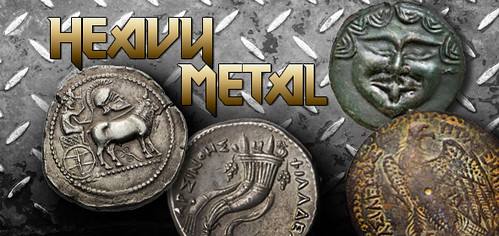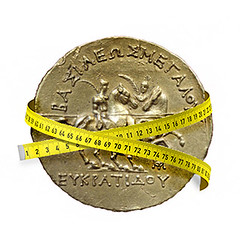
PREV ARTICLE
FULL ISSUE
PREV FULL ISSUE
THE BIGGEST ANCIENT COINSHow do you follow up a great article on THE TINIEST ANCIENT COINS? With another one on the largest ancient coins. Here's an
excerpt from Mike Markowitz' November 18, 2014 CoinWeek article, "Metal Monsters: The Biggest Ancient Coins". -Editor
 Dodekadrachms!
Heavy Bronze/br/>  Olbia was a Greek colony on the northern coast of the Black Sea (now part of Ukraine). Lacking silver, the Olbians–beginning about 450 BCE–issued large cast bronze coins nearly 70 mm in diameter and weighing up to 140 grams. On the obverse, a gorgoneion defiantly sticks out her tongue. To us this image is amusing, but to ancient Greeks it was a protective amulet that repelled evil spirits. On the reverse, an enormous soaring sea eagle clutches a dolphin in its talons. The early Roman Republic also lacked silver, and during the third century BCE various cities cast crude bronze coins called aes grave (“heavy bronze”). The largest pieces weighed a full Roman pound (about 325 grams), and there were a range of fractions down to a half-ounce. Romans were accustomed to using bronze ingots as money, so the inconvenience of these clumsy monsters was relative. Each denomination had a characteristic symbol and mark of value. The obverse of the one-pound “as” bore the double-faced head of Janus, god of doorways. The reverse showed the prow of a warship, with its heavy bronze ram. Many of these pieces originate from a large 19th century Italian hoard. New finds are uncommon, and a controversial agreement with Italy restricts their importation into the US. Prices range from US $3500 to over $7500 for exceptional specimens. The Eucratidion
On the obverse we see the king in profile, wearing a plumed cavalry helmet. On the reverse, the twin heroes Castor and Pollux carry long lances and palm branches and ride prancing horses surrounded by a carelessly lettered inscription: “Great King Eucratides.” The Smithsonian in Washington has a similar 15-stater gold piece of Eucratides that most experts regard as a 19th century fantasy. To read the complete article, see:
To read the earlier E-Sylum article, see:
THE BOOK BAZARREWayne Homren, Editor The Numismatic Bibliomania Society is a non-profit organization promoting numismatic literature. See our web site at coinbooks.org. To submit items for publication in The E-Sylum, write to the Editor at this address: whomren@gmail.com To subscribe go to: https://my.binhost.com/lists/listinfo/esylum All Rights Reserved. NBS Home Page Contact the NBS webmaster 
|
